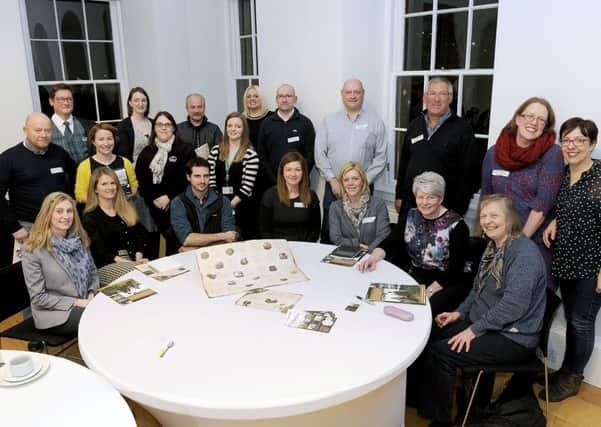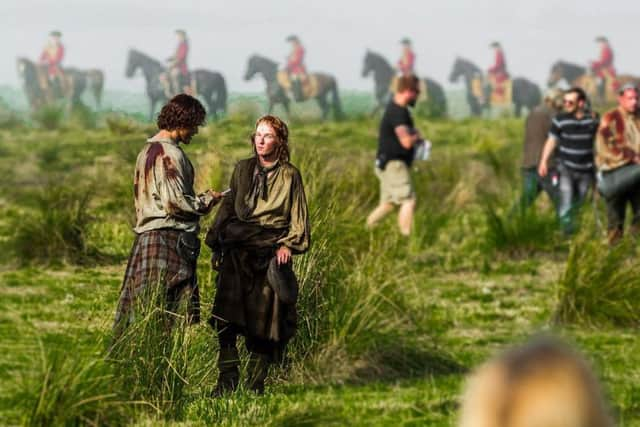It's just tartan fantasy, but '˜set-jetters' love Outlander


Scotland’s main tourism body has issued a statement defining how thrilled it is at the “set-jetting” surge, and its chief executive is confidently predicting much more of the same.
The fact that the film and TV dramas responsible for the apparent success are “haggis and heather” cliches, with little if any bearing on real history or culture, isn’t remotely seen as a problem.
Advertisement
Hide AdAdvertisement
Hide AdThis follows the lead set by Mel Gibson’s hugely successful international blockbuster Braveheart, which had an almost immediate and dramatic effect on visitor numbers to Stirling back in the ‘90’s.


It has since been widely derided as a ludicrous pastiche of any actual historical events which may have happened, laden with gross inaccuracies and outright falsehoods from start to finish – and “sells” a kitsch view of Scottish culture and heritage, replete with clans, tartan and blue face paint.
However it has also been argued that while Braveheart is arrant nonsense, visitors drawn to Scotland by the movie may end up discovering that the truth is even more fascinating than fiction.
Meanwhile Falkirk’s landmark Callendar House hasn’t gained any benefit from film tourism, it appears, as its 2015 visitors figure dropped from 45,491 down to 34,981 in 2016.
Advertisement
Hide AdAdvertisement
Hide AdThe claimed success of several other venues, ranging from Doune castle to Glasgow Cathedral is pinned squarely to their role as movie locations, in a pattern which seems to be similar for fantasy offerings as varied as Harry Potter and Highlander.


The runaway success of Outlander is all the more ironic because it was initially kept off UK terrestrial channels - it has been alleged for political reasons - and instead made its big splash in the USA, where tartan-clad fantasy (and also, to be fair, genuine Scottish culture) are “huge”.
Yet while the first boxed sets of Diana Gabaldon’s cod-Jacobite, bodice-ripper “soap” were finally appearing in DVD shops in Scotland a steady stream of visitors was already arriving at locations such as Blackness Castle - used as the headquarters of Outlander’s number one “baddie”, the psychotic redcoat captain Jack Randall.
For anyone interested in Scottish history, possibly the most appealing choice from the list of film successes offered is the Daniel Craig 007 movie Skyfall, which has an apocalyptic finale on an island where nothing much has actually happened for centuries.
Advertisement
Hide AdAdvertisement
Hide AdIt has zero to do with Scottish history (hence is no embarrassment), and is a stupendous location.
Nor is it the first Bond film to be shot in Scotland, as the Sean Connery movie “From Russia With Love” had two memorable scenes - an explosive boat chase, and a helicopter drama - filmed around Loch Melfort, near Lochgilphead (deputising for somewhere in the former Yugoslavia).
Most embarrassing of the more recent offerings (even more so than Braveheart) could be the enormously successful farrago of nonsense The Da Vinci Code, thanks to its obsession with “Templar mysteries” and its use of Rosslyn Chapel in the plot – to the extent that conservationists have worried the site could be under threat from large volumes of visitors.
Braveheart (1996) is still the tourism chiefs’ ideal, however, as in a single year visits to the (Victorian) Wallace Monument rose from 30,000 to 200,000 a year.
Advertisement
Hide AdAdvertisement
Hide AdPubs and beer firm Belhaven (now part of Greene King), never missing an opportunity, saw the way the wind was blowing and refurbed its Wallace pub at the foot of the monument in a sort of “medieval theme pub” style, complete with reproduction battle-axe ornaments.
However while purists may cavil at the “Disneyfication” of Scottish heritage, VisitScotland chief Malcolm Roughead says he is “blown away” by the global response to Outlander.
It has supplanted Mel’s face-painted warriors, Harry Potter and even Dan Brown’s preposterous, platinum-plated Da Vinci blethers to become “referenced above all others”.
He said: “Film tourism is hugely important for the Scottish economy and year on year we see more and more set-jetters coming to our country to experience for themselves the backdrops that feature in their favourite film or movie.
Advertisement
Hide AdAdvertisement
Hide Ad“This is not a trend that will go out of fashion, so whether it’s heading to Lewis to see where Katie Morag’s adventures began or unlocking the mysteries of the Holy Grail at Rosslyn Chapel, we hope many more will continue to come to Scotland to see the real life movie sets.”
He omits Eilan Donan Castle and its starring role in Monty Python and the Holy Grail - which some might see almost as a documentary, compared to Braveheart or Outlander - but it’s clear that volume is important, and discernment an optional extra, where visitor numbers are concerned.
Sadly one location which probably won’t gain a spike in visitor numbers from Outlander is the film studio nerve centre from where the whole of the first and second series were produced.
Based in a converted empty factory in Cumbernauld it proved to many people that Scotland has the infrastructure and expertise needed to cut it as a serious film base.
Advertisement
Hide AdAdvertisement
Hide AdMost of the outdoors shots were at places like Blackness or Doune, of course, but the series’ version of the 1746 Battle of Culloden was filmed in a field a few minutes’ drive from the heart of the New Town.
What’s it called?
Sadly few “set-jetters” are ever likely to know the answer to that one.